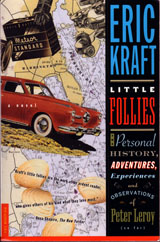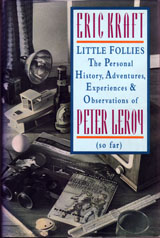

| Little Follies
The Static of the Spheres Chapter 11: Two Regular Joes |
by Eric
Kraft, as Peter
Leroy
|

YOU CAN READ THE FIRST HALF
YOU CAN ORDER THE
|
“There it is, Guppa!” I cried. It was a large cement-block building, painted yellow. The name was painted in enormous black letters along the side and repeated in a huge neon sign on the roof and again in metal letters above the front windows. Guppa pulled off the road and parked in front of the building. When I got out of the car, my knees were weak with excitement. Hand-painted across the door was the motto, “If we don’t got it, you don’t need it,” and as soon as we entered the store, I knew that it was so. The place was entirely filled with things that I had never seen before. Most of what was for sale there did not even resemble anything that I had seen before. Not only was everything unfamiliar, but none of it gave, from outward appearance, any hint of what it was supposed to do or how it might be used. Among stores, Two Regular Joes Electrical Gadgets immediately leaped to the foremost spot in my affection, dropping the Babbington Army-Navy Surplus Store to second and Arnberg’s Hardware and Sick-room Supply to a distant third. The mystery, the subtlety of these gadgets won me immediately; a nail and a hammer give themselves away at once, but a soldering iron and a capacitor do not. I stood inside the door for a few breaths, just looking around, and I think my mouth was hanging open. I know that when I looked at Guppa his mouth was hanging open. Guppa opened his Impractical Craftsman to the list of materials for the receiving set. He looked at the list for a while, muttering to himself, and then he looked up and down the rows of shelves. Directly in front of us were some gadgets made of black-painted metal, roughly rectangular, with an open section in the middle filled with a cylinder that seemed to be made of brown paper. Shiny, coppery wires projected from the bottom of the paper cylinder. These things came in several sizes, and they had a nice heft to them. The paper part was coated with or soaked in wax, and so felt soft and sticky. I hoped that we’d need a few of these. “Do we need any of these, Guppa?” I asked. “Hmmm, let’s see,” he said. He stared at the list for a while. “No, I guess we can do without those,” he said. “How about just one?” I asked. “Peter,” said Guppa, “why don’t you just look around for a while? I’m going to have that clerk help me find some of the things we need. That’ll save some time.” “Okay, Guppa,” I said. Guppa walked over to a counter where a thin, dark-haired man, probably one of the two regular Joes, was reading a newspaper. “Morning,” said Guppa. The man looked up. “Do something for you?” he asked. “My grandson and I are going to build a shortwave receiving set,” said Guppa. “Great,” said the man. He began chewing on his thumbnail. “We’re going to need some parts,” said Guppa. “Wire, for instance, and, well, that sort of thing.” The clerk raised an eyebrow and smiled with only the left side of his mouth. I tried doing it myself. “You got a list?” he asked. “Right here,” said Guppa, and he released lots of air with the words. He opened the magazine on the counter. The clerk looked at the list and said almost at once, “Sure, we’ve got all of this stuff.” “I want only the best,” said Guppa, in a louder voice. “And all new. I don’t want any rebuilt triodes or any of that.” The clerk laughed and shook his head. Guppa knitted his brows for a moment and stared hard at the clerk. Then he relaxed and laughed too. “Heh-heh-heh,” he laughed. “Heh-heh-heh,” the clerk laughed right back. I began examining with minute care some mud-brown cylinders with wires sticking out of each end and bright painted bands of red, yellow, and orange along their sides. |

|
||

Here are a couple of swell ideas from Eric Kraft's vivacious publicist, Candi Lee Manning: Tip the author.
Add yourself to our e-mailing list.
|
Little Follies is a work of fiction. The characters, incidents, dialogues, settings, and businesses portrayed in it are products of the author’s imagination and are not to be construed as real. Any resemblance to actual events or persons, living or dead, is entirely coincidental. All rights reserved. No part of this book may be reproduced or transmitted in any form or by any means, electronic or mechanical, including photocopying, recording, or by any information storage and retrieval system, without permission in writing from the author. “My Mother Takes a Tumble,” “Do Clams Bite?,” “Life on the Bolotomy,” “The Static of the Spheres,” “The Fox and the Clam,” “The Girl with the White Fur Muff,” “Take the Long Way Home,” and “Call Me Larry” were originally published in paperback by Apple-Wood Books. Little Follies was first published in hardcover by Crown Publishers, Inc., 201 East 50th Street, New York, New York 10022. Member of the Crown Publishing Group. YOU CAN ORDER THE
For information about publication rights outside the U. S. A., audio rights, serial rights, screen rights, and so on, e-mail the author’s imaginary agent, Alec “Nick” Rafter. The illustration at the top of the page is an adaptation of an illustration by Stewart Rouse that first appeared on the cover of the August 1931 issue of Modern Mechanics and Inventions. The boy at the controls of the aerocycle doesn’t particularly resemble Peter Leroy—except, perhaps, for the smile. |
|
||||||
| . | . |